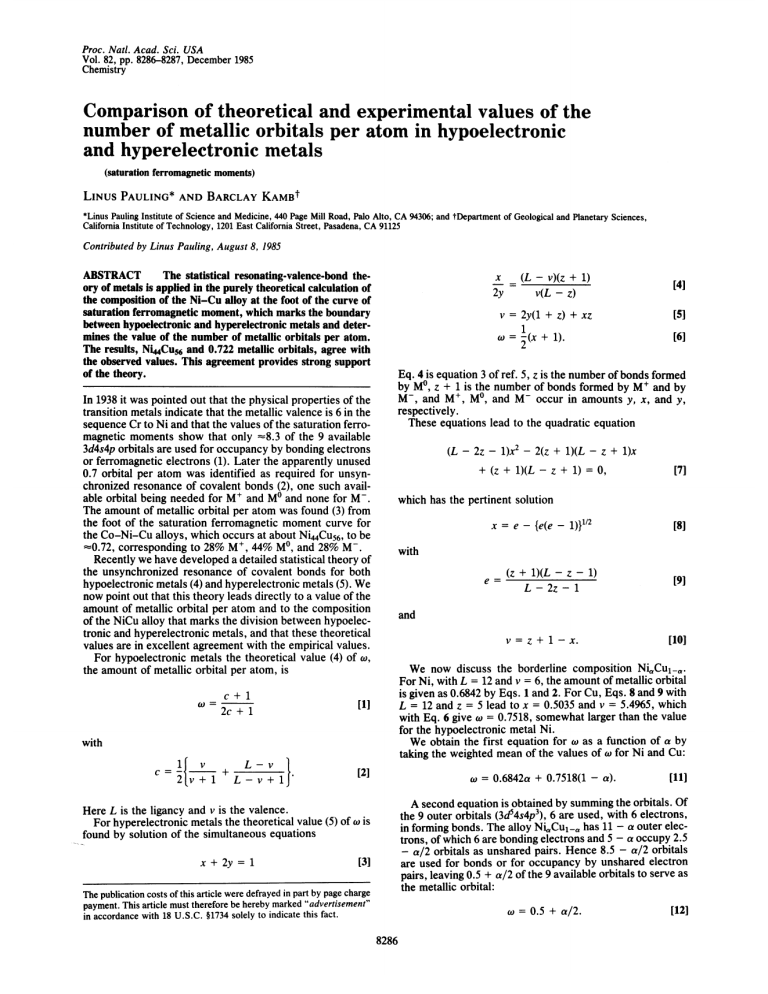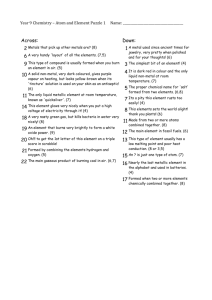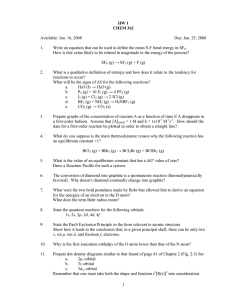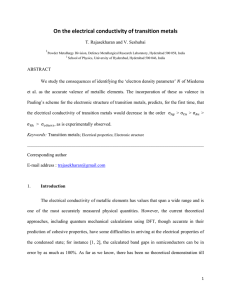Comparison of theoretical and experimental values of the
advertisement

Proc. Nail. Acad. Sci. USA
Vol. 82, pp. 8286-8287, December 1985
Chemistry
Comparison of theoretical and experimental values of the
number of metallic orbitals per atom in hypoelectronic
and hyperelectronic metals
(saturation ferromagnetic moments)
LINUS PAULING*
AND
BARCLAY KAMBt
*Linus Pauling Institute of Science and Medicine, 440 Page Mill Road, Palo Alto, CA 94306; and tDepartment of Geological and Planetary Sciences,
California Institute of Technology, 1201 East California Street, Pasadena, CA 91125
Contributed by Linus Pauling, August 8, 1985
The statistical resonating-valence-bond theABSTRACT
ory of metals is applied in the purely theoretical calculation of
the composition of the Ni-Cu alloy at the foot of the curve of
saturation ferromagnetic moment, which marks the boundary
between hypoelectronic and hyperelectronic metals and determines the value of the number of metallic orbitals per atom.
The results, Ni44Cu56 and 0.722 metallic orbitals, agree with
the observed values. This agreement provides strong support
of the theory.
x
2y
1 v
L-v
+.
2 v +1 L- v+l .
[2]
[6]
[7]
which has the pertinent solution
x
e
=
-
{e(e
-
[8]
1)}1/2
with
(z
1)(L
+
-
z
-
1)
[9]
L-2z- 1
and
V
=
z + 1
-
[10]
x.
We now discuss the borderline composition NiaCulia.
For Ni, with L = 12 and v = 6, the amount of metallic orbital
is given as 0.6842 by Eqs. 1 and 2. For Cu, Eqs. 8 and 9 with
L = 12 and z = 5 lead to x = 0.5035 and v = 5.4965, which
with Eq. 6 give w = 0.7518, somewhat larger than the value
for the hypoelectronic metal Ni.
We obtain the first equation for w as a function of a by
taking the weighted mean of the values of w for Ni and Cu:
=
0.6842a
+
0.7518(1
-
a).
[11]
A second equation is obtained by summing the orbitals. Of
the 9 outer orbitals (3Wd4s4p3), 6 are used, with 6 electrons,
in forming bonds. The alloy NiaCul,, has 11 - a outer electrons, of which 6 are bonding electrons and 5 - a occupy 2.5
- a/2 orbitals as unshared pairs. Hence 8.5 - a/2 orbitals
are used for bonds or for occupancy by unshared electron
pairs, leaving 0.5 + a/2 of the 9 available orbitals to serve as
the metallic orbital:
Here L is the ligancy and v is the valence.
For hyperelectronic metals the theoretical value (5) of w is
found by solution of the simultaneous equations
x + 2y= 1
[5]
(L - 2z - 1)x2 - 2(z + 1)(L - z + 1)x
+ (z + 1)(L - z + 1) = 0,
with
C =-
[4]
Eq. 4 is equation 3 of ref. 5, z is the number of bonds formed
by MO, z + 1 is the number of bonds formed by M+ and by
M-, and M+, MO, and M- occur in amounts y, x, and y,
respectively.
These equations lead to the quadratic equation
c+ 1
[1]
(L - v)(z + 1)
v(L - z)
v = 2y(l + z) + xz
1
O = 2-(X + 1).
2
In 1938 it was pointed out that the physical properties of the
transition metals indicate that the metallic valence is 6 in the
sequence Cr to Ni and that the values of the saturation ferromagnetic moments show that only -8.3 of the 9 available
3d4s4p orbitals are used for occupancy by bonding electrons
or ferromagnetic electrons (1). Later the apparently unused
0.7 orbital per atom was identified as required for unsynchronized resonance of covalent bonds (2), one such available orbital being needed for M+ and MO and none for M-.
The amount of metallic orbital per atom was found (3) from
the foot of the saturation ferromagnetic moment curve for
the Co-Ni-Cu alloys, which occurs at about Ni44Cu56, to be
=0.72, corresponding to 28% M+, 44% MO, and 28% M-.
Recently we have developed a detailed statistical theory of
the unsynchronized resonance of covalent bonds for both
hypoelectronic metals (4) and hyperelectronic metals (5). We
now point out that this theory leads directly to a value of the
amount of metallic orbital per atom and to the composition
of the NiCu alloy that marks the division between hypoelectronic and hyperelectronic metals, and that these theoretical
values are in excellent agreement with the empirical values.
For hypoelectronic metals the theoretical value (4) of w,
the amount of metallic orbital per atom, is
2c + 1
=
[3]
The publication costs of this article were defrayed in part by page charge
payment. This article must therefore be hereby marked "advertisement"
in accordance with 18 U.S.C. §1734 solely to indicate this fact.
w
8286
=
0.5 + a/2.
[12]
Chemistry: Pauling and Kamb
The solution of the simultaneous Eqs. 11 and 12 leads to
the values a = 0.444 and c. = 0.722, in complete agreement
with the observed composition Ni44Cu56 and the corresponding value c. = 0.72.
This agreement provides additional support for the resonating-valence-bond theory of metals and suggests that the
ideas involved in this theory might be helpful in connection
with the more conventional quantum mechanical treatments
of the structure and properties of metals.
Proc. NatL. Acad Sci USA 82 (1985)
8287
We thank the Japan Shipbuilding Industry Foundation (Tokyo) for
partial support of this research.
1. Pauling, L. (1938) Phys. Rev. 54, 899-904.
2. Pauling, L. (1949) Proc. R. Soc. London Ser. A 196, 343-362.
3. Pauling, L. (1960) The Nature of the Chemical Bond (Cornell
Univ. Press, Ithaca, NY), 3rd Ed., pp. 397-399.
4. Pauling, L. (1984) J. Solid State Chem. 54, 297-307.
5. Kamb, B. & Pauling, L. (1985) Proc. Natl. Acad. Sci. USA 82,
8284-8285.





